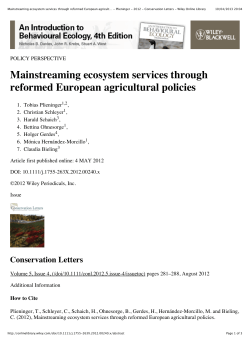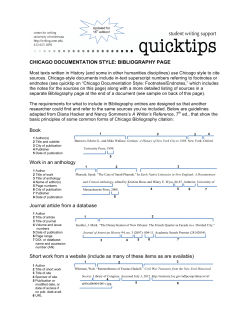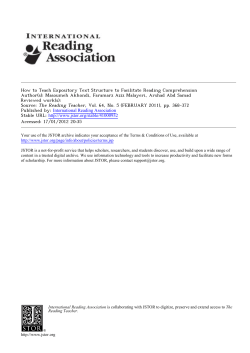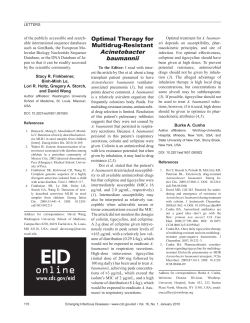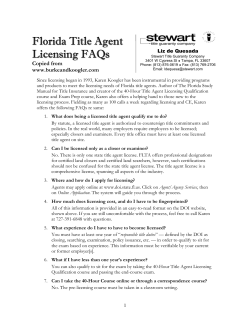
What is macroecology?
Downloaded from on September 30, 2014 What is macroecology? Sally A. Keith, Tom J. Webb, Katrin Böhning-Gaese, Sean R. Connolly, Nicholas K. Dulvy, Felix Eigenbrod, Kate E. Jones, Trevor Price, David W. Redding, Ian P. F. Owens and Nick J. B. Isaac Biol. Lett. 2012 8, doi: 10.1098/rsbl.2012.0672 first published online 22 August 2012 References This article cites 20 articles, 5 of which can be accessed free Subject collections Articles on similar topics can be found in the following collections /content/8/6/904.full.html#ref-list-1 ecology (780 articles) Email alerting service Receive free email alerts when new articles cite this article - sign up in the box at the top right-hand corner of the article or click here To subscribe to Biol. Lett. go to: /subscriptions Downloaded from on September 30, 2014 Recently, a macroecology special interest group of the BES was formed. The inaugural meeting brought together a diverse group of researchers to review the evolution of macroecology as a research discipline, highlight recent notable developments and explore new applications. Nick Isaac described the aims of the BES macroecology group, which include providing a forum to share ideas and concepts, promoting data access and standards, showcasing methodological advances and setting the agenda for future research. This was followed by a keynote address from Ian Owens, who presented a personal perspective on the development of macroecology throughout the past decade. Owens argued that macroecology has been revolutionized by a combination of the availability of large molecular phylogenies, high-resolution datasets on geographical distribution, extensive computational power and new analytical approaches. As a result, rapid advances have been made towards answering many of the questions that originally occupied macroecologists, such as variation in body size, geographical range dynamics, and the role of neutral processes. These advances have brought with them a new set of opportunities and challenges [5], many of which were recurrent themes during the day. These themes are summarized below. Biol. Lett. (2012) 8, 904–906 doi:10.1098/rsbl.2012.0672 Published online 22 August 2012 Community ecology Meeting report What is macroecology? Sally A. Keith1, Tom J. Webb3, Katrin Bo¨hningGaese4, Sean R. Connolly1,2, Nicholas K. Dulvy5, Felix Eigenbrod6, Kate E. Jones7, Trevor Price8, David W. Redding7, Ian P. F. Owens9 and Nick J. B. Isaac10, * 1 Australian Research Council Centre of Excellence for Coral Reef Studies, and 2School of Marine and Tropical Biology, James Cook University, Townsville, Queensland 4811, Australia 3 Department of Animal and Plant Sciences, University of Sheffield, Sheffield S10 2TN, UK 4 Biodiversity and Climate Change Research Centre, Goethe University, Frankfurt, Germany 5 Earth to Ocean Research Group, Department of Biological Sciences, Simon Fraser University, Burnaby, British Columbia, Canada V5A 1S6 6 Centre for Biological Sciences, University of Southampton, Southampton SO17 1BJ, UK 7 Department of Genetics, Evolution and Environment, University College London, Gower Street, London WC1E 6BT, UK 8 Department of Ecology and Evolution, University of Chicago, 1101 East 57th Street, Chicago, IL 60637, USA 9 Natural History Museum, Cromwell Road, London SW7 5BD, UK 10 Centre for Ecology and Hydrology, Benson Lane, Crowmarsh Gifford, Wallingford OX10 8BB, UK *Author for correspondence (njbi@ceh.ac.uk). 2. FROM PATTERN TO PROCESS The strongest theme that percolated all of the talks was the increased emphasis on the processes that drive biodiversity patterns (see also [5]). This theme was introduced by Owens, who outlined a shift from describing patterns to a search for mechanistic understanding. In other words, the way we address key research questions has changed, notably by the increased use of process-based conceptual models of biodiversity [6]. This theme was further developed by Sean Connolly, who identified a mismatch between the biological reasoning that underpins hypotheses about the drivers of macroecological patterns and the statistical models that are actually fitted to data. Connolly illustrated how this has hindered progress in our understanding of large-scale species-richness gradients, and demonstrated how models based on biological processes can be used to derive testable hypotheses [7]. Although macroecology is relatively advanced in its use of statistical methods, the theoretical basis of the predictions involved is sometimes poorly developed. Connolly argued that the explicit formulation of theoretical models, and the robust derivation of statistical expectations from those models, is one of macroecology’s most significant challenges. Katrin Bo¨hning-Gaese provided a clear demonstration of how incorporating local processes can influence largescale patterns of species distributions. For example, projections of the impact of climate change on bird species richness yielded very different results when biotic interactions with tree species were taken into account [8]. Similarly, Trevor Price emphasized that both biotic and abiotic factors can explain large-scale diversity gradients. He showed how niche conservatism is not enough to explain diversity gradients of Himalayan birds, unless competitive interactions are incorporated. Kate Jones and David Redding showed how the spread of a zoonotic disease (Lassa fever) can only be understood with The symposium ‘What is Macroecology?’ was held in London on 20 June 2012. The event was the inaugural meeting of the Macroecology Special Interest Group of the British Ecological Society and was attended by nearly 100 scientists from 11 countries. The meeting reviewed the recent development of the macroecological agenda. The key themes that emerged were a shift towards more explicit modelling of ecological processes, a growing synthesis across systems and scales, and new opportunities to apply macroecological concepts in other research fields. Keywords: macroecology; spatial scale; process-based model; theory; ecosystem; disease 1. INTRODUCTION The idea of macroecology as a distinct field of research has been around for more than two decades [1] and was conceived as a response to the realization that small-scale local processes alone were not able to fully explain the abundance and distribution of species. This led to a broader perspective that searched for generalized patterns at large spatial and temporal scales [2], characterized by the search for statistical relationships to explain the distribution of biodiversity from a historical and geographical perspective [2,3]. Ten years ago, a symposium of the British Ecological Society (BES) was convened with the aim of reconciling divergent perspectives on large-scale ecological patterns. This ‘Causes and Consequences’ symposium set the tone for a decade of research in macroecology [4]. Received 18 July 2012 Accepted 1 August 2012 904 This journal is q 2012 The Royal Society Downloaded from on September 30, 2014 Meeting report. What is macroecology? reference to the distribution of the host (a rat). Moreover, Nicholas Dulvy described how the thermal tolerance of individual organisms underpins the distribution of poikilothermic animals in the oceans, and their responses to recent climate change, but that this was not the case on land [9]. Dulvy speculated that gross differences between marine and terrestrial environments can be attributed to the importance of behavioural thermoregulation and interspecific competition on land, contrasting with the dominance of size-based competition in marine systems. The increasing focus on mechanistic understanding in macroecology is not confined to this meeting [5,10], and many of the recent attempts to build unified theories in ecology have been process-based [11–14]. A key challenge now is to derive general and testable predictions via robust theoretical modelling, underpinned by biologically reasonable assumptions. Recent progress in this area has been substantial [6], although many current theories may not be testable even for data-rich taxa, such as mammals [15]. Thus, further research to bridge the gap between theory, predictions and data is a priority for the development of macroecology into the future. 3. BREAKING DOWN BARRIERS Traditionally, macroecology focused on processes operating at large scales (e.g. climatic and phylogenetic), largely ignoring the potential for small-scale processes to generate a coherent signal in macroecological patterns [16]. One reason is the deficit of fine-grained (e.g. population-level) datasets that are replicated over large spatial extent [5]: national monitoring schemes have great potential in this regard [17]. A growing body of evidence, both theoretical and empirical, suggests such signals can be detected (see above). Conversely, Bo¨hning-Gaese showed large-scale abiotic gradients can influence community assembly. One striking example is that the degree of specialization, identified using interaction networks among pollinator and frugivore species, is greater in temperate than in tropical communities, contrary to expectation [18,19]. Bo¨hning-Gaese argued that advances in understanding how ecological patterns are generated at multiple spatial scales, and how they are interrelated, are important steps towards a multi-scale synthesis across ecology. An additional barrier to progress within ecology in general is the lack of synthesis across taxonomic groups and biomes. Historically, macroecology was no exception, being predominantly focused on terrestrial vertebrates [5], although marine macroecology was well-represented at this meeting. A feature of the presentations by marine ecologists was that the concepts and analyses they use are not exclusive to the marine environment. Connolly’s process-based models of species richness are wholly transferrable to terrestrial cases. Dulvy went further, arguing that contrasts between realms can discriminate among hypotheses. For instance, equator-ward range limits on land were previously explained as an artefact of under-sampling in the tropics, but the contrast with changing marine range limits in the tropics, where scientific capacity is also low, suggested that stagnant terrestrial ranges are real [9]. More generally, inter-realm comparative Biol. Lett. (2012) S. A. Keith et al. 905 analyses provide many novel opportunities to test mechanistic macroecological hypotheses [20]. 4. NEW APPLICATIONS The meeting demonstrated well how macroecology has influenced diverse research agendas, further reinforcing its application to public policy on biodiversity [21,22]. Owens argued that the influence of macroecology has been unusually broad and deep at the interface of science and policy, especially around land-use, climate change and biodiversity loss. Thus, a significant opportunity exists for macroecology to remain influential and adapt to changing priorities of stakeholders and funding bodies. Two talks focused specifically on the extent to which macroecological ideas are gaining traction in mapping ecosystem services (MES) and epidemiology. MES, and the potential trade-offs among them, is ripe for the application of macroecological approaches. Like macroecology, MES examines correlations in space over large scales, for example, calculating the degree of spatial overlap of multiple services. Felix Eigenbrod argued MES should adopt macroecological tools to identify the mechanisms underpinning the distributions of ecosystem services. A further challenge for MES lies in the necessity to consider linkages between the distribution of biophysical stocks and their potential beneficiaries, which is somewhat analogous to modelling overlapping geographical ranges of interacting species. For example, Bo¨hning-Gaese incorporated species richness of fig trees (the stock) into predictive models for frugivorous birds (the beneficiaries) [23]. Therefore, the incorporation of co-occurrence and subsequent interactions within both research agendas may be an area that would benefit from collaboration. A further case study was presented by Jones and Redding, who argued that biodiversity may provide an ecosystem service of disease regulation, thereby contributing to human health. They contrasted traditional epidemiology, which is highly mechanistic and often treats diseases in isolation, with the emerging field of ‘disease macroecology’, which searches for general patterns in the emergence of novel diseases [24,25]. Jones described how this approach can address policy-relevant questions about emerging infectious diseases and provide a context for mechanistic models of epidemiology at large spatial scales. 5. CONCLUSIONS Macroecology has clearly matured from its descriptive, pattern-based, roots and now strives for explicit mechanistic ecological understanding. Key questions about the distribution of organisms in space and time remain central to the research agenda, but the conceptual and analytical approaches have changed markedly [5]. The growth of macroecology as both an applied science and a theoretical endeavour is also remarkable. In conclusion, we identify three key ways in which macroecology could progress: (i) close the conceptual gap between data and theory; (ii) enhance integration of replicated field (i.e. fine-grained) studies across the Downloaded from on September 30, 2014 906 S. A. Keith et al. Meeting report. What is macroecology? macroecological scale; (iii) deepen and extend collaboration across realms, biomes and taxonomic groups (including microbes [26]), in order to determine the extent to which patterns and processes are truly general across all biodiversity. The symposium was organized by N.J.B.I., S.A.K. and T.J.W., and was funded by the BES. T.J.W. is supported by the Royal Society, S.A.K. and S.R.C. by the Australian Research Council and N.K.D. by Natural Sciences and Engineering Research Council of Canada. We are grateful to Rob Freckleton, Georgina Mace and Albert Phillimore for advice and support, and to all the participants for attending. 1 Brown, J. & Maurer, B. A. 1989 Macroecology: the division of food and space among species on continents. Science 243, 1145–1150. (doi:10.1126/science.243. 4895.1145) 2 Gaston, K. J. & Blackburn, T. M. 2000 Pattern and process in macroecology. Oxford, UK: Blackwell Science. 3 Brown, J. H. 1995 Macroecology. Chicago, IL: University of Chicago Press. 4 Blackburn, T. M. & Gaston, K. J. 2003 Macroecology: concepts and consequences: The 43rd Annual Symposium of the British Ecological Society. Cambridge, UK: Cambridge University Press. 5 Beck, J. et al. 2012 What’s on the horizon for macroecology? Ecography 35, 673–683. (doi:10.1111/j.1600-0587. 2012.07364.x) 6 McGill, B. J. 2010 Towards a unification of unified theories of biodiversity. Ecol. Lett. 13, 627 –642. (doi:10. 1111/j.1461-0248.2010.01449.x) 7 Connolly, S. R. 2009 Macroecological theory and the analysis of species richness gradients. In Marine macroecology (eds J. D. Witman & K. Roy), pp. 279 –309. Chicago, IL: University of Chicago Press. 8 Kissling, W. D., Field, R., Korntheuer, H., Heyder, U. & Bo¨hning-Gaese, K. 2010 Woody plants and the prediction of climate-change impacts on bird diversity. Phil. Trans. R. Soc. B 365, 2035–2045. (doi:10.1098/rstb. 2010.0008) 9 Sunday, J. M., Bates, A. E. & Dulvy, N. K. In press. Thermal tolerance and the global redistribution of animals. Nat. Climate Change. (doi:10.1038/nclimate1539) 10 McGill, B. J. & Nekola, J. C. 2010 Mechanisms in macroecology: AWOL or purloined letter? Towards a pragmatic view of mechanism. Oikos 119, 591 –603. (doi:10.1111/j.1600-0706.2009.17771.x) 11 Hubbell, S. P. 2001 The unified neutral theory of biodiversity and biogeography. Princeton, NJ: Princeton University Press. 12 Harte, J., Zillio, T., Conlisk, E. & Smith, A. 2008 Maximum entropy and the state-variable approach to macroecology. Ecology 89, 2700–2711. (doi:10.1890/07-1369.1) Biol. Lett. (2012) 13 Morlon, H., Chuyong, G., Condit, R., Hubbell, S., Kenfack, D., Thomas, D., Valencia, R. & Green, J. L. 2008 A general framework for the distance-decay of similarity in ecological communities. Ecol. Lett. 11, 904 –917. (doi:10.1111/j.1461-0248.2008.01202.x) 14 Brown, J. H., Gillooly, J. F., Allen, A. P., Savage, V. M. & West, G. B. 2004 Towards a metabolic theory of ecology. Ecology 85, 1771–1789. (doi:10.1890/03-9000) 15 Jones, K. E., Blackburn, T. M. & Isaac, N. J. B. 2011 Can unified theories of biodiversity explain mammalian macroecological patterns? Phil. Trans. R. Soc. B 366, 2554–2563. (doi:10.1098/rstb.2011.0119) 16 Paine, R. T. 2010 Macroecology: does it ignore or can it encourage further ecological syntheses based on spatially local experimental manipulations? Am. Nat. 176, 385 – 393. (doi:10.1086/656273) 17 La Sorte, F. A. & Jetz, W. 2012 Tracking of climatic niche boundaries under recent climate change. J. Anim. Ecol. 81, 914 –925. (doi:10.1111/j.1365-2656.2012. 01958.x) 18 Schleuning, M., Blu¨thgen, N., Flo¨rchinger, M., Braun, J., Schaefer, H. M. & Bo¨hning-Gaese, K. 2011 Specialization and interaction strength in a tropical plant – frugivore network differ among forest strata. Ecology 92, 26–36. (doi:10.1890/09-1842.1) 19 Donatti, C. I., Guimara˜es, P. R., Galetti, M., Pizo, M. A., Marquitti, F. M. D. & Dirzo, R. 2011 Analysis of a hyper-diverse seed dispersal network: modularity and underlying mechanisms. Ecol. Lett. 14, 773 –781. (doi:10.1111/j.1461-0248.2011.01639.x) 20 Webb, T. J. In press. Marine and terrestrial ecology: unifying concepts, revealing differences. Trends Ecol. Evol. (doi:10.1016/j.tree.2012.06.002) 21 Kerr, J. T., Kharouba, H. M. & Currie, D. J. 2007 The macroecological contribution to global change solutions. Science 316, 1581 –1584. (doi:10.1126/science. 1133267) 22 Burger, J. R. et al. 2012 The macroecology of sustainability. PLoS Biol. 10, e1001345. (doi:10.1371/journal.pbio. 1001345) 23 Kissling, W. D., Rahbek, C. & Bo¨hning-Gaese, K. 2007 Food plant diversity as broad-scale determinant of avian frugivore richness. Proc. R. Soc. B 274, 799 –808. (doi:10.1098/rspb.2006.0311) 24 Jones, K. E., Patel, N. G., Levy, M. a, Storeygard, A., Balk, D., Gittleman, J. L. & Daszak, P. 2008 Global trends in emerging infectious diseases. Nature 451, 990 –993. (doi:10.1038/nature06536) 25 Keesing, F. et al. 2010 Impacts of biodiversity on the emergence and transmission of infectious diseases. Nature 468, 647 –652. (doi:10.1038/nature09575) 26 Azovsky, A. & Mazei, Y. In press. Do microbes have macroecology? Large-scale patterns in the diversity and distribution of marine benthic ciliates. Glob. Ecol. Biogeogr. (doi:10.1111/j.1466-8238.2012.00776.x)
© Copyright 2025
